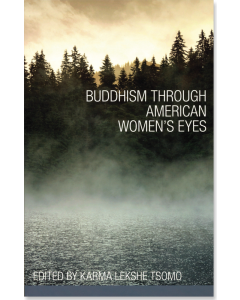The following excerpt is adapted from
Buddhism through American Women’s Eyes
edited by Karma Lekshe Tsomo


Karma Lekshe Tsomo is a professor in the Department of Theology and Religious Studies at the University of San Diego, where she teaches Buddhism, World Religions, and Comparative Religious Ethics. She studied Buddhism in Dharamsala, India, for fifteen years and received a doctorate in Philosophy from the University of Hawaii. She is a founder and past president of Sakyadhita: International Association of Buddhist Women, and director of Jamyang Foundation, an innovative education project for women in developing countries.

Michele Levey on The Power of Loving Kindness
The following excerpt is adapted from
edited by Karma Lekshe Tsomo
The Power of Loving-Kindness by Michele Levey
Creating a field of loving kindness is a very powerful meditation for daily life. Loving kindness and a good heart create the most powerful protection. The red cord that lamas give as a blessing during ceremonies actually stands for loving kindness. Buddha Shakyamuni was able to overcome all hindrances and temptations through the power of his loving kindness.
I learned a very beneficial technique for generating loving kindness and transforming negativity from a Bengali teacher of the Burmese Theravada tradition, Dipa Ma. She is considered a saint, highly attained, and pure of mind. When someone asked her, “What are the qualities of your mind?” she answered, “My mind has three qualities: concentration, equanimity, and loving kindness. That’s it.”
In this meditation, we focus awareness on the flow of the breath rising and falling in the chest. Notice any feelings of warmth, tingling, vibration, or movement at the heart and allow that region to become soft, open, and radiant. All of us can remember being in the presence of someone with strong loving kindness. Bask in that feeling of warmth, affection, and caring.
To do this meditation authentically, first we need to send a lot of love to ourselves. This is very difficult for some people, but to perfect this practice, we need to care about ourselves, too. We bring to mind our own image, like looking in a mirror, and repeat the following phrases softly:
May I be free from enmity: May I be free from aversion, ill will, hatred, and anger, hostility, and irritation toward myself and others.
May I be free from danger: May I be free from all harms, diseases, accidents, and other dangers.
May I be free from disease: May I be healthy on all levels.
May I be happy: May my heart be open, truly happy, and all wishes fulfilled.
May I be free from suffering: May I be free from all physical, mental, and emotional sufferings.
As we breathe in, we breathe in all feelings of loving kindness, happiness, and caring, filling our whole being.
Next, calling to mind an image of a teacher or friend who has been very kind, visualize someone who naturally arouses these feelings. Focus on that person as representing all our kind relatives, friends, benefactors, and helpers. Behold that person’s face as clearly and vividly as possible, generate loving kindness, and again repeat:
May you be free from enmity.
May you be free from danger.
May you be free from disease.
May you be happy.
May you be free from suffering.
Now allow that image to dissolve back into empty space and out of that emptiness, generate an awareness of all the suffering beings in the world, a general, pervasive sense of all the many beings around the globe who are suffering mentally, physically, and emotionally. Allow the spontaneous flow of images to arise in your mind, direct the focus of your concentration on loving kindness to all types of suffering beings, and repeat:
May we be free from enmity. May we be free from disease. May we be free from danger. May we be happy. May we be free from suffering.
Imagine what it would be like to go beyond the words of this meditation to the feelings pointed to by the words. Imagine what it would be like to build the strength of those feelings so that they become a radiant, powerful way of being with which to move through our daily life and work. Our life can become a source of blessing to the world or it can add to the already mounting confusion and anxiety. The choice is up to us. Through “everyday Dharma” practice, we begin building the foundation of right relations. This allows our minds to be calm and free from turbulence. A calm mind, in turn, is the necessary foundation for developing concentration and clarity, which allow the emergence of wisdom and insight. Through deepening insight, our compassion also deepens and manifests as even better relations in our day-to-day life. In this way, our practice follows the cycle of the three higher trainings of ethics, concentration, and wisdom. We go full-circle in an ever-increasing upward spiral of integrating and celebrating the inextricable interweaving of our spiritual work and our daily lives.

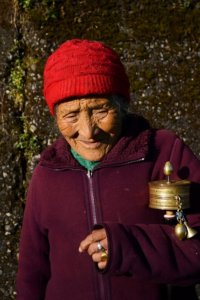
Tibetan Nuns: Refugees in India
| The following article is from the Autumn, 1990 issue of the Snow Lion Newsletter and is for historical reference only. You can see this in context of the original newsletter here. |
Om Tashi Dondrup! The crisp morning air sparkled with their shouts as the group of men raised a tall wooden flagpole hung with prayer cloth. They were welcoming in another New Year in the Tibetan Refugee camp of Lobsering, India.
At every home in the small community the ritual would be repeated, the men running happily from place to place. The women of the household came out bearing a large, intricately carved, painted wooden box mounded with barley flour. Everyone took a pinch to toss and again chanted,
"Om Tashi Dondrup!–Please may this be a prosperous year!"
I had come to Lobsering to renew my connection with the students of Ani Jetsun Drolma. Ani Jetsun, the woman who through the strength of her practice manifested many remarkable abilities, had made her power accessible to the troubled Tibetan refugees in the camps of Orissa. Their lives had been so miserable then, having fled their native land for refuge in India.
"She was for the poor. Whatever you needed, she could help you get it, be it money, food, a place to stay, protection, comfort in our pain . . . she never let us feel hopeless."
The villagers did not see her often as she was always in retreat. However, when they climbed through the snake infested jungle to her hut they knew they would be helped. Her death in 1979, accompanied by rainbows and many miraculous signs, left her students struggling to maintain their practice in the face of extreme poverty.
"Come quickly!" Kyizom, the eldest daughter of Singye and Tseten Drolma tugged my sleeve. "Everyone is starting to gather on the hill."
Her parents had brought the plight of Ani Jetsun's students to the attention of a western nun, Karma Lekshe Tsomo. When I was visiting Lekshe in Dharamsala on my way to Orissa, she asked for my help. I went to Lobsering in 1988, wrote an article which was published in the Snow Lion Newsletter (A Life of Discipline, a Rainbow Death), and received some donations.
Another tug on my sleeve, and I turned around just in time to steady old Ani Pema who was struggling to maintain her balance in the dusty road. In one hand she brandished a wooden cane, in the other she waved a kata, the traditional white blessing scarf. At 78 years old the small donations we had sent her through the year had enabled her to remain independent. She had come to say her thanks.
At the top of the hill, five white parachutes had been erected, like sprouting mushrooms or exotic teepee umbrellas. The people of Lobsering are from different parts of Tibet, each having its own traditional prayers. They gathered under separate parachute umbrellas so that the whole camp could pray and feast together at the gathering but still maintain the individual traditions of their ancestors.
The maintenance of tradition is a high priority with the refugees. When His Holiness the Dalai Lama came to visit the camp he requested them to be strong and not give up their identity as Tibetans with a cultural heritage.
Throughout the year most of the able-bodied leave the camp in order to earn money, usually selling shoes or sweaters on the sidewalk in populated Indian cities. The elderly and the children stay behind to maintain the camps. But everyone comes home to celebrate Losar together.
Some children were running noisily up a small path to the left of the gathering. Kyizom and I followed them. A row of small rooms and a graceful stupa looked out over the fields and the distant, purple hills. This was the site of a three-year retreat center in the lineage of His Holiness Dudjom Rinpoche.
A group of monks had completed their retreat last year. Now Ani Tsultrim Palmo had been allowed to occupy one of the small rooms. She was sitting before her shrine, chanting softly when we arrived. She gestured to the modest offerings on her shrine.
"Your friends have made it possible for me to stay in retreat," she said. "I always offer part of everything I am given in their name."
We went outside and sat while she made a small fire for tea.
"Where will you cook when the rains come?" I asked. "Where will you go when the monks come for retreat?" She smiled.
"I will deal with things as they arise," she assured me. We watched the late afternoon sun cast its long shadows and relished Ani Palmo's serenity.
People had dispersed to their own family celebrations as we made our way through the jungle to Ani Kadak's hut. She was going to the village to perform a Tara puja for a family but she paused when she saw us coming.
"Ani-la, is there anything that we can do to make you more comfortable?" I asked, a question I would repeat to each of the women we are supporting. She was so poor; her hut was dark and ramshackle, empty of anything we could call comfort.
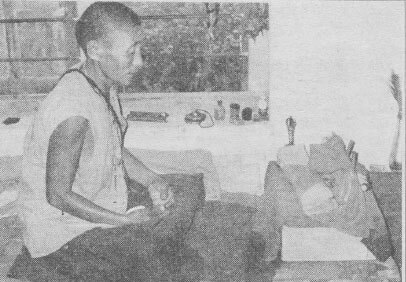
Ani Tsultrim Palmo, Lobsering, India.
"Yes," she said, "the farmers have put a fence across my path. It is difficult to get my water buckets over." I could easily imagine that. Ani Kadak is 73. She hauls water a quarter of a mile uphill. She does not want us to move her to a better spot. It is peaceful in the jungle.
"Ani-la," I ventured, "your blanket is full of holes. May I get you a new blanket?"
"No," she said, "it is not good to have too much. What I have is plenty. Besides, I am an old woman. I will die soon. What will happen to that new blanket then?" She laughed and walked us down the path as darkness settled softy over the camp.
Suddenly, up roared Singye on a blazing red Rajdoot motorcycle. "I borrowed it," he said. "There is dancing in camp #5."
Kyizom and I climbed aboard and off we went, down winding cattle trails and over rattling bridges through the velvet blackness. After some time there were lights and the laugh of children. We could hear the singing, first the men, then the women.
Circling in ceremonial steps, chanting an epic of their people, the men wore high hats with different colored flags while the women were crowned with flowers. The dancing went on and on . . . The people dreamt of a land of abundance and high mountain passes. They remembered the days of heroes and freedom.
The next day, fortified by the ever-full cup of steaming butter tea, I visited the other nuns to whom we had been sending donations.
Ani Tsultrim Wangmo was standing in the courtyard of her sister's house. She told us she was going to Nepal to see her teacher, His Holiness Dilgo Khyentse Rinpoche. I asked her how she was going to get there.
"Someone will provide," she replied.
"Where will you stay? What will you eat?"
"I will beg," she replied.
"Is there anything we can give you for your journey?"
She smiled and shook her head slowly. The radiance of her face took my breath away.
Ani Tenzin Drolma was very happy at the old people's home. Singye gave her some rupees from our fund for medicine and for making offerings at her shrine during the holy days.
Ani Tsering Drolma requested a cooking pot. She had only one and wanted to cook her rice and vegetables separately.
Ani Yountro wanted to help with our prayer flag project so we wandered back to Singye's house where a small crowd had gathered. Singye was covered with black ink. So was the wooden block carved with mantras and auspicious animals. Now if all that enthusiasm could be transferred to the bright cloth stretched out before us, we'd be in business.
I packed my bag slowly. This visit had flown by. As I stood to leave, Singye filled my tea cup yet another time. When I protested he informed me that I wasn't to drink it. "This is so that you will come back," he said.
We walked down the road together, sounds of merriment coming from a neighbour's house. We caught up with Ani Pema, cane in one hand, bucket in the other, on her way to the well at the edge of the camp.
"Ani-la," I told her, "Please go to the Tibetan doctor. We have made an arrangement with him to give you medicine for your arthritis."
She shook her cane at me. "I am not going to take any more medicine," she said. "I am too old. I will die soon. I have no need for medicine. But I am telling you, we will all meet in Dewachen."
The bus approached, banging and rattling down the road. I had a fourteen-hour ride ahead of me, and the bus was packed to the gills.
A young Tibetan called my name and gestured me to his seat. I remembered meeting him at Singye's house. He was in the Indian army, stationed on the Ladakh border at 20,000 feet. He had walked up the road several miles in order to save a seat for me.
"The fare is paid," he said as he struggled to exit through the packed and seething multitude. My eyes filled with tears.
"Tashi Deleg!" Tseten Drolma shouted over the din, "may all be auspicious!"
Prema Dasara
Click on donations and/or humanitarian aid to see current projects with the Tara Dhatu Charity Fund. Donations are tax deductible.
"Tara Dhatu, which means the pure realm of the Goddess Tara."—Prema Dasara, Spiritual and Creative Director, Tara Dhatu
What can you do to support Tibetan Nuns?
Learn more at the Tibetan Nuns Project.
"In 1987, many nuns began escaping from Tibet in search of religious and educational freedom. The majority of the nuns were destitute and illiterate, and they arrived in a refugee community already struggling to survive. These dedicated women wanted to live, study, practice, and teach in accordance with their spiritual beliefs.
"Traditionally, Buddhist nuns have not had the same access to education as monks. The Tibetan Nuns Project aims to elevate the educational standards and the position of women. We created a groundbreaking education system aimed at both preserving Tibetan culture and empowering the nuns to live and become leaders in the modern world.
"By supporting the Tibetan Nuns Project, you are giving hundreds of Tibetan Buddhist nuns in India the opportunity to practice their religion in a safe and empowering environment, at a time when the Tibetan culture and religion is severely under threat. You are opening doors for these dedicated women through education so that they can, for the first time in the history of Tibet, stand alongside men as equals and as teachers and leaders."
See their video by clicking here.
For more information:

Karma Lekshe Tsomo is a professor in the Department of Theology and Religious Studies at the University of San Diego, where she teaches Buddhism, World Religions, and Comparative Religious Ethics. She studied Buddhism in Dharamsala, India, for fifteen years and received a doctorate in Philosophy from the University of Hawaii. She is a founder and past president of Sakyadhita: International Association of Buddhist Women, and director of Jamyang Foundation, an innovative education project for women in developing countries.
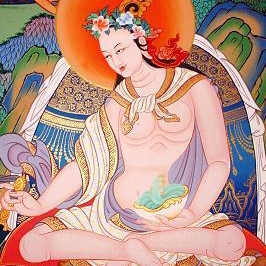
Yeshe Tsogyal is perhaps one of the most well-known female practitioners of Tibetan Buddhism. A beloved disciple and partner of Padmasambhava, Tsogyal achieved great realization and became a teacher herself.
$18.95 - Paperback
$24.95 - Paperback
By: Thubten Chodron & Bhikshuni Jendy & Venerable Bhikshuni Master Wu Yin
$39.95 - Hardcover
By: Heidi L. Nevin & J. Jakob Leschly & Khenpo Ngawang Pelzang & Khenpo Ngawang Palzang
The Life and Visions of Yeshe Tsogyal
$24.95 - Paperback
By: Chonyi Drolma & Dzongsar Jamyang Khyentse & Drime Kunga & Yeshe Tsogyal

| The following article is from the Autumn, 1987 issue of the Snow Lion Newsletter and is for historical reference only. You can see this in context of the original newsletter here. |
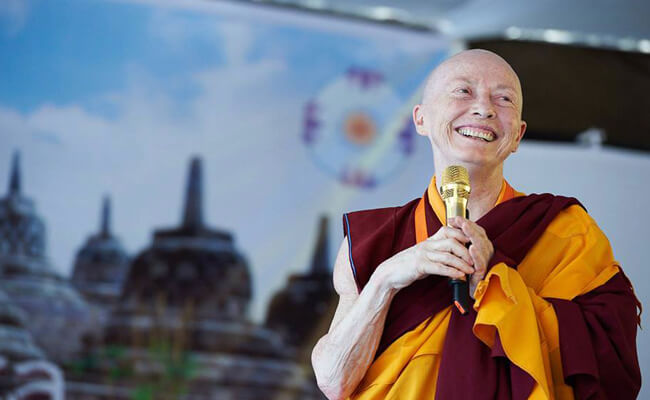
The Tibetan Nuns Project was started and is being coordinated by Ani Karma Lekshe Tsomo who is an American-born Buddhist nun who presently studies at the Buddhist School of Dialectics in Dharamsala, India. She created the first International Conference on Buddhist Nuns, held in February 1987 at Bodhgaya, India which was attended by hundreds of nuns.
Participation in the project will provide basic subsistence, education, and the necessary health and housing conditions for the spiritual practice of dedi-cated Tibetan women. Your support will permit aspirants to join the spiritual community. You may make a general donation to the Tibetan Nuns Project or you may choose a specific nunnery (locations available upon en-quiry).
There are two ways to con-tribute: (1) Send a check to The Tibet Fund, 107 East 31st. St., New York, NY 10016. SPECIFY Tibetan Nuns Project. This is tax-deductible. (2) Send an International Money Order or personal check by registered mail to: Ani Karma Lekshe Tsomo, c/o Buddhist School of Dia-lectics, Dist. Kangra, H.P. 176 219 INDIA.

